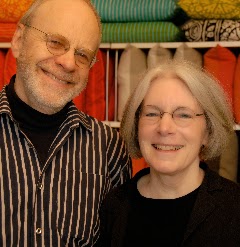 |
| Maynard Hale Lyndon and Lu Wendel Lyndon |
Maynard Hale Lyndon and Lu Wendel Lyndon were integral parts of the famous Design Research (D/R) store before they founded their own firm, Placewares. They are part of the history of modern design in the United States. When they moved up to Sea Ranch, retirement wasn’t in the cards, so they set up a small shop and gallery in Gualala, the town immediately north of Sea Ranch. It is very much like an updated but miniature version of Design Research, without all the furniture. It is one of my favorite stores anywhere, and I wanted to know the Lyndons’ story. When you look at Morley Baer’s photographs of MLTW’s early Sea Ranch houses, you see they feature a lot of Marimekko fabrics, one of the mainstays of D/R and now Placewares. It’s a wonderful big circle.
Maynard and Lu thought New Year’s Day would be quiet and a good time for a conversation. But design devotees are a loyal bunch, and customers began calling almost as soon as we sat down. The seasoned shopkeepers slipped in and out of conversation with grace, and it was only later I realized they had sold a fair amount of merchandise during our interview.
Interviewer: How did you get started in design?
Lu Lyndon: When I was out of college, I moved from San Francisco to Cambridge and discovered D/R. And like many people, it’s where I went on Saturday, what I did for recreation. I would just go hang out in the store because it was so beautiful.
Maynard Lyndon: This was the original store in the wood frame house on Brattle Street?
Lu Lyndon: Right. This was in the early 1960s. A year later I moved back to San Francisco and worked as a legal secretary. A woman I worked with said to me one day that her sister was coming to visit. She told me that she worked for Design Research and that she was scouting a location for a store in San Francisco. And I said, “I have to meet your sister.”
The sister didn’t think I was tall enough, blond enough, whatever enough, and sort of said she didn’t think she was interested in my working at D/R. And I said, “Well, I’d be happy to come and help. I know you need hands to set up the store. I’ll do anything you need.” I just wanted to be there. So I helped set up the store. And then I managed to worm myself into working there on Saturdays. I had a fulltime job during the week, and on Saturdays I put on my Marimekko dress and went to work at D/R. Over time I was given a fulltime job and then became the assistant store manager. When the Beverly Hills store lost its manager, I worked there temporarily before being promoted to be part of the buying group in Cambridge—talk about a big circle!
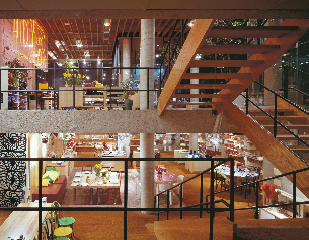 |
| Ben Thompson’s D/R store in Cambridge. Courtesy Chronicle Books |
Interviewer: Did you have a design background?
Lu Lyndon: I never really had much design training. I was an English Lit major in college. But my passion is design. And so it’s been a lifelong career and love for me. And I met this guy. That helped.
Interviewer: Did you meet in Cambridge?
Lu Lyndon: No, I actually met Maynard after I was given the position in Cambridge, while I was still in Beverly Hills. The president of D/R at the time said, “You need to find a replacement for yourself and train that person before we can move you, because we can’t let Beverly Hills flounder.” Meanwhile Maynard was interviewing for a position as product development director. D/R was trying to put together a team of three people to develop new products— Ristomatti Ratia, the son of Marimekko’s founder, Armi Ratia; Craig Hodgetts, an architect from Los Angeles; and Maynard.
Maynard Lyndon: One of us being in Boston, one of us in Los Angeles, and one in Helsinki. That was the plan.
Craig was designing a new building for D/R to be built in Beverly Hills, which never happened.
While D/R was setting up this department, they needed a store manager for Beverly Hills. They said, “You might as well learn the culture of this company directly by managing the Beverly Hills store; when the board gets the funding together, we’ll begin the design department back East.”
Lu Lyndon: So a year later, Maynard came back to Cambridge. But by then things started going really awry with D/R. Once Ben Thompson was out of the picture, there was a succession of different people who were in charge, and the heart and soul went out of the company.
We both left and started our own business, which was a design-build firm. We did graphics. We did space planning for lawyers, for medical people, and for people in their private homes—whatever work we could find. This was 1973—there wasn’t a lot of work.
Maynard Lyndon: Annual reports, a whole series of things. Wielding hammers, paint brushes, Letraset—whatever was needed to get the job done!
Lu Lyndon: We were very poor.
Maynard Lyndon: We called that company Placemakers. We were making places for people.
Lu Lyndon: One of the projects that we had was for a couple who owned the train station building in Concord. There were a number of little stores within the train station, but there was no system for moving people through the building, so we came up with a signage scheme. At one meeting, the owners were all down in the doldrums, and we asked, “What’s wrong?” They said, “Well, our major tenant just stole away in the middle of the night, leaving the main store space empty.”
Maynard and I looked at each other and thought, well, we know a little bit about retail. So we put together a store for them. The arrangement was that they would put up the money, and we would do the store—the concept, the layout, the build-out, the buying, the displays, the necessary backroom systems, hiring and training staff—and we would run it for six months or so and then we would leave. It was called Plum Loco.
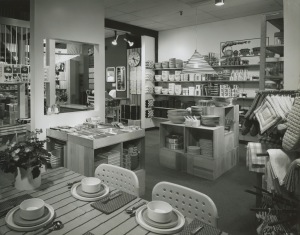 |
| Plum Loco store in Concord Train Station designed by Maynard and Lu Lyndon Photo by Steve Rosenthal |
Maynard Lyndon: After three years there, we said, “We’ve got to do our own store.” We came up with the name Placewares and opened our first store on January 11, 1978. So this January, it is 33 years since we started the original Placewares.
Lu Lyndon: By that point, we had already put together a unique collection of products that we had sourced from all over the world.
Maynard Lyndon: Our tagline for that first store was “a newfangled hardware store.” We got a lot of attention at the time, because our store was the first to focus on storage and organization as a category. From our design/build days, we had learned that most people have plenty of living space; they simply don’t use it very well. What we offered in our stores were products that could help people use their spaces better. Our tag line changed to “specializing in places to put things” and then to “the storage and organization resource.”
Lu Lyndon: We opened our first store in Concord, because we knew the Concord customer from our years at the train station store.
Maynard Lyndon: As we expanded—at one time we had seven stores—we would literally count the number of Volvos in the parking lots.
Lu Lyndon: That was the qualifier. Volvo owners were people who were sensitive to design and function and durability—and had a degree of disposable income.
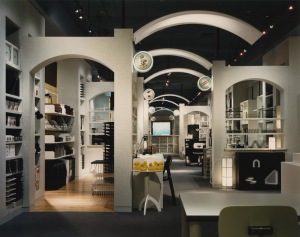 |
| One of the Lyndons’ Placewares stores in the Boston area. |
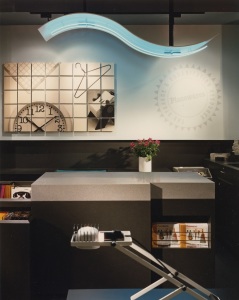 |
| One of the Lyndons’ Placewares stores in the Boston area. |
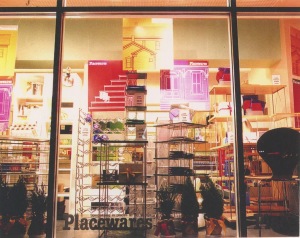 |
| One of the Lyndons’ Placewares stores in the Boston area. |
Interviewer: And the name of your own store was Placewares?
Lu Lyndon: Yes. We coined that name, meaning “wares for your place.” Because we advertised fairly heavily in Boston Magazine, people would come out to Concord. When the 1979 gas shortage happened, customers said, “You know, you have to have a store in town.” We decided that if we opened a store in Boston, we had to go to the premiere shopping area, and that would be Newbury Street. So the second store was on Newbury Street.
Maynard Lyndon: We were there for 26 years.
Interviewer: What did you sell?
Lu Lyndon: The same product mix as the store in Concord—storage and organization.
Interviewer: Tell me about LyndonDesign.
Lu Lyndon: We started LyndonDesign, which is the second part of the name of our store/gallery here in Gualala, in 1983. We were designing product largely in response to our customers’ wishes and requests for things that they couldn’t find to fit their needs.
We didn’t want to be the manufacturer or the marketer or distributor, so we’ve always worked on a royalty arrangement.
But since we’ve moved here, we’ve downplayed product design and are doing the gallery instead. We combined the names when we reopened here—Placewares+LyndonDesign—to enable us to still design some things if someone asks, but we’re not pursuing product or interior design like we used to. In the gallery, we’re developing a coterie of artists who are doing special things in different materials. The whole focus of the gallery has been architecture and landscape.
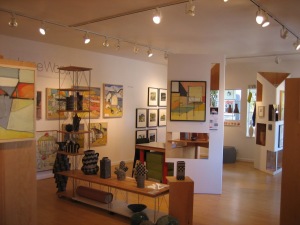 |
| The gallery wing of Placewares+LyndonDesign in Gualala. |
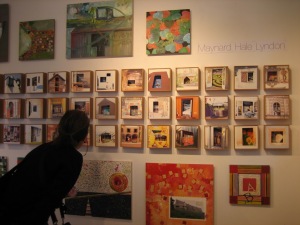 |
| Maynard Lyndon’s recent collage constructions on exhibit. |
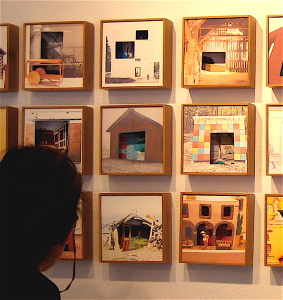 |
| Maynard Lyndon’s recent collage constructions. |
Interviewer: Which of course is what Sea Ranch is about. Maynard, let’s go back to how you got into the design world. I know about your father’s practice in Los Angeles.
Maynard Lyndon: Yes, Maynard Lyndon, FAIA, was my father (that’s why I use all three names, Maynard Hale Lyndon), and my mother, Jo Hale Lyndon, was a consultant to my father’s architectural practice. She did all the colors for his buildings. She also opened a store in Detroit that she and he designed together, called Contemporary Backgrounds.
My mother had gone to the New York 1938 exposition at MoMA of Alvar Aalto’s work and was so taken with all that collection of things—the glass and the furniture—that she became the second importer and retailer of Aalto pieces in America. In Detroit, my father was doing very modern, award-winning schools.
Contemporary Backgrounds opened in 1940, and it wasn’t so far away from Cranbrook and what was happening there. It was a very exciting time. I don’t remember it personally, but of course I have some photographs. (My brother, Donlyn Lyndon, FAIA, did an exhibit at UC Berkeley and then at UC Santa Barbara about Contemporary Backgrounds.)
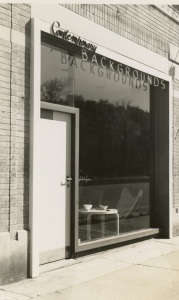 |
| Contemporary Backgrounds Photo by Maynard Lyndon, FAIA |
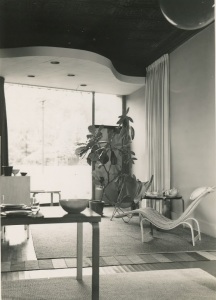 |
| Contemporary Backgrounds Photo by Maynard Lyndon, FAIA |
We still have some original Aalto pieces from that store in our house here. This type of design was engrained in my childhood.
Dad went to an exposition of new housing ideas in the early 1940s in Los Angeles where he saw a house that Richard Neutra designed. It was a 1936 plywood house, two-story, a very early use of plywood, partially demountable. You could take it apart in sections and move it. My father came back to the office in Detroit and called Neutra and introduced himself as an architect. They became friends and collaborated together later. Dad bought that house from the exposition over the phone. Meanwhile, he bought a lot in West Los Angeles outside of Westwood and had the house moved to that site. As a young child, I grew up in this house; it was amazing. We lived in that house until Dad designed his own house out in Malibu in 1949. You can see Julius Shulman’s photos of it in Barbara Lamprecht’s book on Neutra.
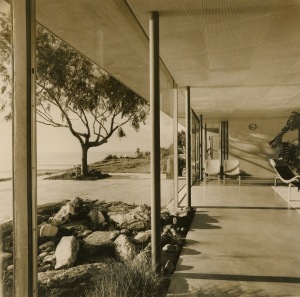 |
| Malibu House designed by Maynard Lyndon, FAIA, 1949. Photo by Maynard Lyndon, FAIA |
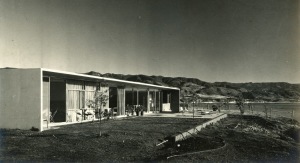 |
| Malibu House designed by Maynard Lyndon, FAIA, 1949. Photo by Maynard Lyndon, FAIA |
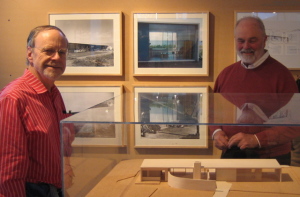 |
| Maynard and Donlyn Lyndon, FAIA at exhibit of Maynard Lyndon, FAIA’s work in Los Angeles. Pictured here is their family home designed by Maynard Lyndon, FAIA from 1949. |
I went to architecture school at Cal Poly, San Luis Obispo, and then to painting school at the Chouinard Art Institute in downtown Los Angeles.
Interviewer: What was your first business?
Maynard Lyndon: A toy store on Wilshire Boulevard in Santa Monica I founded in 1967. I called it Colorform. I designed and built the store, designed the toys, made the toys. I started a little manufacturing company called ColorformLine, making a line of children’s furniture in three garages in Santa Monica.
After two or three years, I was getting a lot of attention in the press, and unbeknownst to me, the president of Creative Playthings, which was in Princeton, appeared on our doorstep. I didn’t know who he was; I didn’t even know Creative Playthings particularly. We walked around the block several times that day, and by the end of that conversation, he said, “We want you to come back East and head our product development for Creative Playthings.”
Creative Playthings had been bought by CBS, the television network. They were buying these little companies thinking that they should branch out. So within very few months, I sold my store to one of my customers and moved to Princeton to head the product development for Creative Playthings, which was an amazing experience.
I had I think 17 designers and engineers under my umbrella and a secretary. This corporate world was very new to me! Eventually, CBS rid themselves of all of these fun little companies. But it launched me into a totally different world of understanding how things are made, how designers work with manufacturers, and how things are distributed.
Interviewer: How old were you?
Maynard Lyndon: I was in my 20s. It was a fantastic situation. Later I returned to California, where I became product development director for Forms+Surfaces, Santa Barbara, an architectural hardware and finishes company.
And again, I got into another whole layer of things that was a great learning experience. But the owner had never had somebody besides himself doing the design. And finally I just said, “This isn’t going to work. There can’t be two of us.” And I begin looking for something else. I responded to an ad by this company, Design Research, and ended up meeting with then-CEO Peter Sprague.
Interviewer: He had done the takeover?
Maynard Lyndon: Yes, and Phil Doub was then president. I met with them in San Francisco and Los Angeles. And they said, “Well, we’re trying to convince the board to start a product development team of our own.” And that’s when this whole idea started, but they didn’t have the money put together.
It’s odd the way the world happens. And so there I was. Lu trained me at D/R Beverly Hills for about two weeks before D/R moved her back to Cambridge.
Beverly Hills was a totally different world than Princeton or Cambridge. And I had this staff of 15 to 20, all women except the stock boy. I had to learn how to deal with their various quirks, and they had to learn to deal with my quirks. About a year later D/R moved me back to Cambridge, where I managed their flagship store for a while.
Interviewer: How did you get from Placewares in Boston to here?
Maynard Lyndon: Both of us have been coming to Sea Ranch since the 1960s even before we knew each other. In 1997 on a trip to visit my brother Donlyn (the “L” of MLTW), we thought, “Well, just for fun, let’s see if there’s any property available that seems right and that we can afford.” We always wanted to be out here. We found a lot, bought it, and went back to Boston and continued to work. But we began designing our house with Donlyn. He did the siting and shaping of the house and we did the interiors. Matt Sylvia built it; it was the last house he finished. Interestingly—in relation to your big circle notion—Matt used to build Neutra houses in Los Angeles before Sea Ranch invited him to come build up here. He built over 150 homes at Sea Ranch. Our house was finished in 2000, and for four years after that we commuted back and forth to Boston.
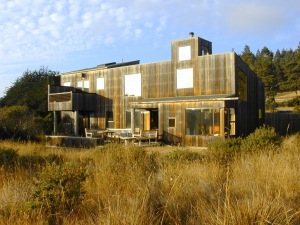 |
| Maynard and Lu Lyndon’s Sea Ranch house. Architecture by Donlyn Lyndon, FAIA |
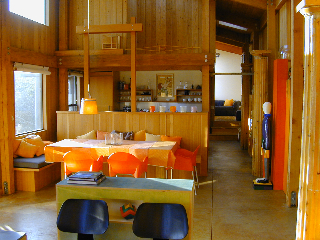 |
| Inside the Lyndons’ home at Sea Ranch. |
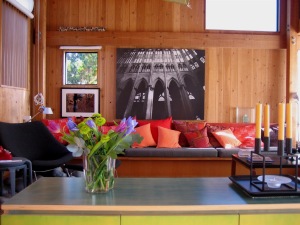 |
| Inside the Lyndons’ home at Sea Ranch. |
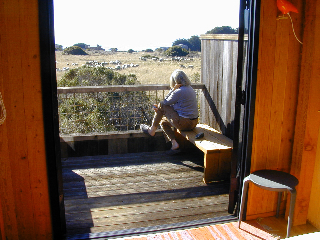 |
| The view over the sheep meadow. |
By the 26th anniversary of Placewares in 2004, we said, “We’ve done this long enough. It’s time to move on.”
We gathered all our employees together at our Boston headquarters and told them we were closing the stores down and we would help them find other employment. And that’s what we did. Every two weeks, we closed a store and consolidated the merchandise and whatever remaining staff. The last location to close was our first store, in Concord. On the very last day, there were just the two of us, just the way we had started 26 years earlier.
Within months, we were out here at Sea Ranch full time with the idea to continue the design practice, because we still had various royalty arrangements. We thought that would sustain us, but we missed all the contact with people.
And so we began asking ourselves and family and people we were meeting up here, “What does this town need?” People said, “We need a quick photo place. We need a drycleaner. A messenger service.” In Lu’s Mini Cooper, we could have the Mini Messenger Service. Lu thought about a madeleine baking company.
But finally we said, “Why don’t we just do what we know how to do? But let’s change the LyndonDesign part, and let’s do a gallery because there are so many talented artists up here.”
So now we are back doing what we love and talking with people directly. And Lu, you should take over talking about it. You haven’t had a chance to say a word.
Lu Lyndon: I used to tease Maynard when we interviewed prospective new employees. When you do an interview, you’re supposed to let the interviewee do the talking. I used to have to nudge Maynard because he was the one who was doing all the talking, describing Placewares to the interviewee!
Interviewer: So do you feel like this is the essence of what you were about, getting to the pure designs and art, without the huge overhead and delivery and operations and finance?
Lu Lyndon: When we were planning this store, the big question was, what is really needed here? What kinds of things do we know about that would resonate in this community? I first found Sea Ranch in the late 1960s while I was working at D/R—I didn’t know Maynard or Donlyn then. People would come to D/R to furnish their houses up here.
On my first visit I just fell in love with Sea Ranch. And I said to myself, “Someday I’m going to live here.” And luckily for me, someday happened. But the store really is a response to the community. It is a way for us to give something back and to be able to continue our love of sourcing new products and finding interesting, good, well-designed things. And sharing them with our customers.
I have always been very careful that whatever I acquire is well-designed and beautiful and enduring. I have this attitude that that’s the way we need to live. It’s hard to be sour about the world if you’re surrounded by beautiful things—and interesting people! It’s also a very sustainable approach to living. If the things you have are things you love, you’re not throwing them away and replacing them every two years.
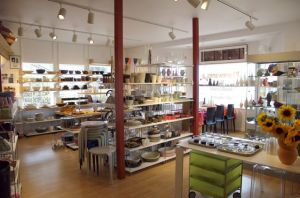 |
| Placewares+LyndonDesign in Gualala. |
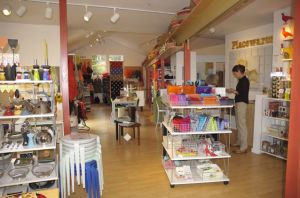 |
| Placewares+LyndonDesign in Gualala. |
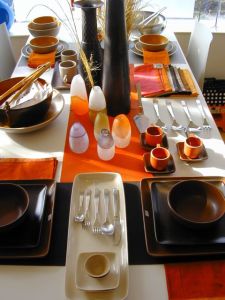 |
| Placewares+LyndonDesign in Gualala. |
The Finnish designer Kaj Franck designed a line of dishes for Iittala in 1952. They are the dishes I bought from D/R for my first apartment; we still use them today at home, and we sell them in our store. His whole attitude was to keep things simple. Buy things that you love and use them every day. Don’t put them in a cupboard for special occasions. They’re part of your life. I feel very fortunate to have known both Armi Ratia, who founded Marimekko, and Ben Thompson, who was D/R. And to be able to continue what they began, in some small way in this little outpost in Gualala….
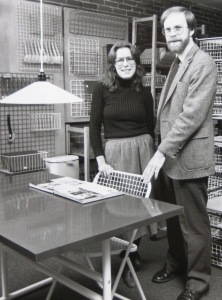 |
| Maynard and Lu Lyndon at their first Placewares store in January 1978. |
All photos courtesy Maynard Hale Lyndon and Lu Wendel Lyndon except as noted.
Further information:
Placewares+LyndonDesign
http://www.placewares.com/
Design Research Book
http://www.chroniclebooks.com/index/main,book-info/store,books/products_id,8937/
http://www.archpaper.com/e-board_rev.asp?News_ID=4886&PagePosition=4
The Sea Ranch
http://www.papress.com/html/book.details.page.tpl?isbn=9781568983868